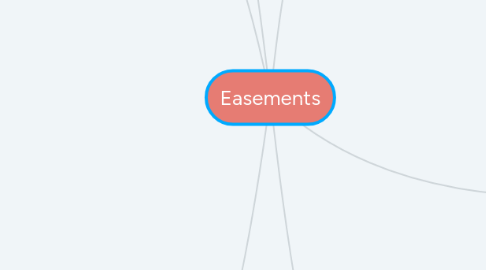
1. Legal Easements
1.1. Easements are legal interests, by virtue of S1(2) LAW OF PROPERTY ACT 1925.
1.2. To be legal, an easement must:
1.2.1. 1. Be for a tern equivalent to the legal estate; and
1.2.2. 2. Be in the form of a deed if created by express grant or reservation.
2. Equitable Easements
2.1. An easement which is not for a term equivalent to the legal estate, or one created other than by deed or statute will be equitable.
2.2. s53(1) LAW OF PROPERTY ACT 1925 provides that equitable interests must at least be in writing.
2.3. For unregistered land, an equitable easement created after January 1926 must be registered at the Land Charges Register as a Class D(iii) Land Charge.
2.4. For registered land, an equitable easement will usually be protected by entry of a notice on the register.
3. Creating Easements
3.1. GRANT of Easements
3.1.1. EXPRESS GRANT
3.1.1.1. One property owner expressly agrees that another should have an easement over his land. To be legal, the easement must be made by deed (s52 LPA 1925) and be equivalent to the legal estate.
3.1.2. IMPLIED GRANT
3.1.2.1. 1. Necessity:
3.1.2.1.1. An easement will be implied if it is absolutely necessary, for example where land is landlocked and there is no means of access without a right of way.
3.1.2.1.2. SWEET & ANOTHER V SOMMER & ANOTHER: It was absolutely necessary to destroy a workshop to allow access.
3.1.2.2. 2. Common Intention
3.1.2.2.1. An easement will be implied where it is clear that the parties intended this
3.1.2.2.2. LIVERPOOL CITY COUNCIL v IRWIN: In the absence of any express grant of easement, it was clear that an easement had been implied to allow tenants to use the stairs and lifts to reach their 9th and 10th storey flats.
3.1.2.3. 3. The rule under WHEELDON v BURROWS
3.1.2.3.1. Where a person divides his land and sells one part, he must ensure that no implied easements are being created in favour of the buyer unless the following conditions can be met:
3.1.3. PRESCRIPTION
3.1.3.1. Prescription implies that where a person can prove that they have exercised a right for 20 years or more, he is presumed to have an easement by prescription.
3.1.3.2. In order for prescription to occur, the following must be satisfied:-
3.1.3.2.1. 1. There must be CONTINUOUS USER.
3.1.3.2.2. 2. Use must have continued for the PRESCRIPTIVE PERIOD (usually 20+ years)
3.1.3.2.3. 3. Use must be BY, OR ON BEHALF OF, AND AGAINST, THE FEE SIMPLE.
3.1.3.2.4. 4. Use must have been AS OF RIGHT, i.e. exercised without force, secrecy or permission.
3.1.3.3. There are three methods of prescription:
3.1.3.3.1. A. COMMON LAW - Where an easement has been enjoyed since time immemorial (now considered by the courts to be 20 years or more), it is presumed that the user has acquired an easement by prescription.
3.1.3.3.2. B. DOCTRINE OF LOST MODERN GRANT - Whereby an easement has been exercised for 20 years and the courts make a fictional assumption that the deeds have been lost.
3.1.3.3.3. C. PRESCRIPTION ACT 1832 - Where an easement must have been used for at least 20 years. If 40+ years use can be shown, the right is deemed to be absolute and cannot be made void.
3.2. RESERVATION of Easements
3.2.1. Where an owner sells part of his land but retains the right to use an easement over the land which he has sold.
4. Characteristics of an easement
4.1. The case of RE ELLENOROUGH PARK 1956 established the four characteristics of an easement.
4.1.1. (1) There must be two pieces of land, a dominant tenement (benefits from the easement) and a servient tenement (subject to the burden of the easement).
4.1.2. (2) The easement must benefit the dominant tenement.
4.1.3. (3) There must be diversity of ownership and occupation, i.e. different people must own and occupy the dominant and servient tenements.
4.1.4. (4) The right granted must be capable of forming the subject matter of a deed, and therefore must meet the following requirements:-
4.1.4.1. A. The right claimed must be similar to existing easements.
4.1.4.2. B. There must be no positive obligation on the servient owner to expend money (except in the case of fences).
4.1.4.3. C. The right claimed must be sufficiently definite.
4.2. There can be no exclusive possession, i.e. the dominant owner cannot exclude the servient owner from the land. Rights of storage cause problems here.
4.2.1. 1. In WRIGHT v MACADAM, use of a garden shed for the storage of coal was sufficient to form an easement. In contrast, GRIGSBY v MELVILLE established that the right to store goods in a cellar amounted to exclusive possession, thus as easement could not exist.
4.2.2. 2. In BATCHELOR v MARLOW, the right to park and store a car was not capable of forming an easement as it allowed the dominant owner exclusive possession. However, LONDON & BLENHEIM ESTATES LTD v LADBROKES RETAIL PARKS LTD established that the right to park cars could be an easement.

